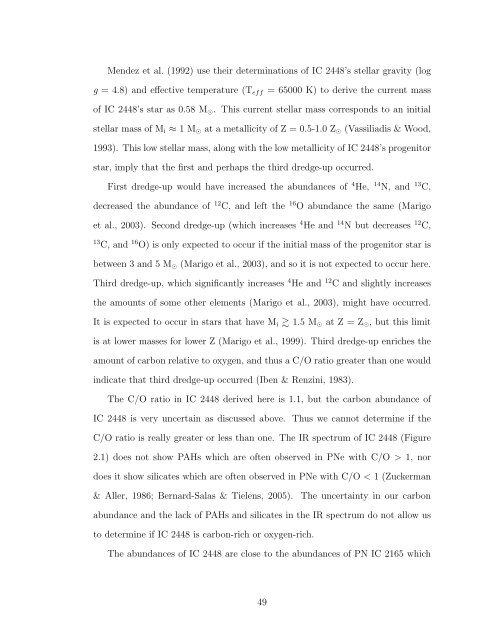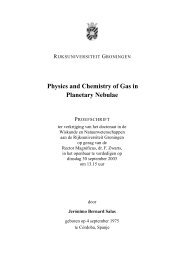TRACING ABUNDANCES IN GALAXIES WITH THE SPITZER ...
TRACING ABUNDANCES IN GALAXIES WITH THE SPITZER ...
TRACING ABUNDANCES IN GALAXIES WITH THE SPITZER ...
Create successful ePaper yourself
Turn your PDF publications into a flip-book with our unique Google optimized e-Paper software.
Mendez et al. (1992) use their determinations of IC 2448’s stellar gravity (log<br />
g = 4.8) and effective temperature (Teff = 65000 K) to derive the current mass<br />
of IC 2448’s star as 0.58 M⊙. This current stellar mass corresponds to an initial<br />
stellar mass of Mi ≈ 1 M⊙ at a metallicity of Z = 0.5-1.0 Z⊙ (Vassiliadis & Wood,<br />
1993). This low stellar mass, along with the low metallicity of IC 2448’s progenitor<br />
star, imply that the first and perhaps the third dredge-up occurred.<br />
First dredge-up would have increased the abundances of 4 He, 14 N, and 13 C,<br />
decreased the abundance of 12 C, and left the 16 O abundance the same (Marigo<br />
et al., 2003). Second dredge-up (which increases 4 He and 14 N but decreases 12 C,<br />
13 C, and 16 O) is only expected to occur if the initial mass of the progenitor star is<br />
between 3 and 5 M⊙ (Marigo et al., 2003), and so it is not expected to occur here.<br />
Third dredge-up, which significantly increases 4 He and 12 C and slightly increases<br />
the amounts of some other elements (Marigo et al., 2003), might have occurred.<br />
It is expected to occur in stars that have Mi � 1.5 M⊙ at Z = Z⊙, but this limit<br />
is at lower masses for lower Z (Marigo et al., 1999). Third dredge-up enriches the<br />
amount of carbon relative to oxygen, and thus a C/O ratio greater than one would<br />
indicate that third dredge-up occurred (Iben & Renzini, 1983).<br />
The C/O ratio in IC 2448 derived here is 1.1, but the carbon abundance of<br />
IC 2448 is very uncertain as discussed above. Thus we cannot determine if the<br />
C/O ratio is really greater or less than one. The IR spectrum of IC 2448 (Figure<br />
2.1) does not show PAHs which are often observed in PNe with C/O > 1, nor<br />
does it show silicates which are often observed in PNe with C/O < 1 (Zuckerman<br />
& Aller, 1986; Bernard-Salas & Tielens, 2005). The uncertainty in our carbon<br />
abundance and the lack of PAHs and silicates in the IR spectrum do not allow us<br />
to determine if IC 2448 is carbon-rich or oxygen-rich.<br />
The abundances of IC 2448 are close to the abundances of PN IC 2165 which<br />
49













